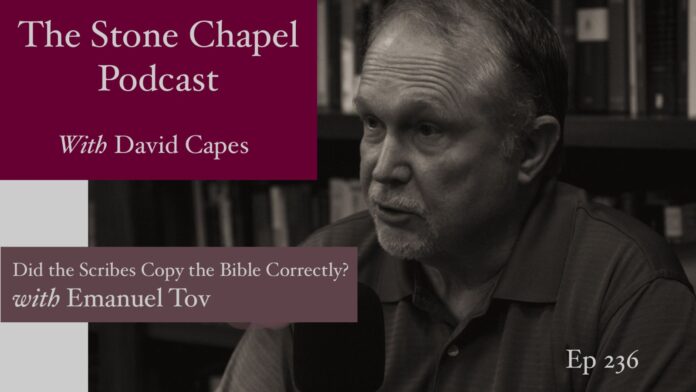► Listen on Amazon
► Listen on Apple
► Listen on Spotify
► Listen on YouTube
You can find previous episodes of “The Stone Chapel Podcast” at Lanier Theological Library.
“The Stone Chapel Podcast” is part of the ChurchLeaders Podcast Network.
This transcript has been edited for clarity and space.
David Capes
One of the ways that we tell one individual from another is that they have different handwritings. So, I’m wondering, can you identify some of these scribes by the handwriting?
Emanuel Tov
It’s a million-dollar question. One of the riddles is, how many individuals can we recognize among the 950 different fragmentary scrolls from Qumran. It would make sense that we might recognize 10 or 50 different hands, but we really haven’t. First of all, it’s very difficult, because some of these handwritings are very formal. Just think about modern handwriting. It’s very difficult. There has been one scholar, Dr. Ada Yardeni, a great, great paleographer. Paleography is a study of ancient handwriting. She had a very special view, and she thought that she could identify one scribe, let’s call him X, who had written
50 different scrolls. Her view has not been accepted, actually, by anyone, but there’s been a very interesting development.
There’s a few scrolls that we can identify. It was one scribe that we are quite sure, according to his handwriting and some idiosyncrasies relating to the writing of the name of God that we know that he has written. First of all, a copy of the community scroll. And one of the copies of Samuel and the corrections in the large Isaiah scroll. Two corrections in the large Isaiah scroll. So that’s one individual. And so we can find him in three, or maybe four scrolls. Also we see him in 4Q175 in four different sources. But the most exciting news is actually not yet known in the world. It hasn’t been fully publicized because it’s is a research project led by Professor Mladen Popovic in Groningen in the Netherlands that works with methods of artificial intelligence. They fed I think, some 150 different scrolls into a computer.
Now you take the different stents, the different positions of the letter. Let’s say you take a lamed [Hebrew letter than makes the sound “el”] and ask whether the top line is completely straight or is it a little bit to the left, five degrees, 10 degrees, 15 degrees. And you put that all into the computer now, without thinking at all about the content of the writing. But just the formal technical data. One scholar, Emma Hayes has found a group of eight different scrolls copied by one particular scribe. This is in her dissertation. It is not yet published, so we’re waiting for her book. I completely accept her view, in particular, because it agrees with my own theory about certain writing styles.
I think this is a wonderful new avenue of research about the identity of scribes. But at the same time, you should realize that we haven’t found answers to the main question. Namely of those 950 different papyri, in very few cases, were we able to find the identity of scribes that wrote more than one scroll. It’s too bad that all the scribes remain anonymous, because in ancient times, at least in this part of the world, unlike in Mesopotamia, these scribes are anonymous. They don’t say, I’m called Moshe, the son of Aaron who writes this scroll. They don’t say anything.
So, we remain grasping in the dark with regard to the scribe. We have to start thorough research, and that’s what I’ve been doing for 25 years. Looking into the details of these scribes in order to know more about them, starting with the smallest details about letters, about ways of correcting, about dots here and dots there, about the ways in which they were writing. Precisely in the ways in which some scribes were writing sloppily. You get to know about the personality of some scribes. I think that also Dr. Yardeni was a videographer, but also a calligrapher herself. I think she also knew that certain scribes
were left-handed rather than right-handed, so you learn quite a bit about these scribes by meticulous research.
David Capes
Now these scribes, they weren’t all the same. Some had more skill than others. Some had been scribes just a short period of time. Some were senior scribes. Did they have different duties? Because some of the younger scribes may not have copied certain kinds of material, whereas a senior scholar might have copied something else. Do we know that at this point?

